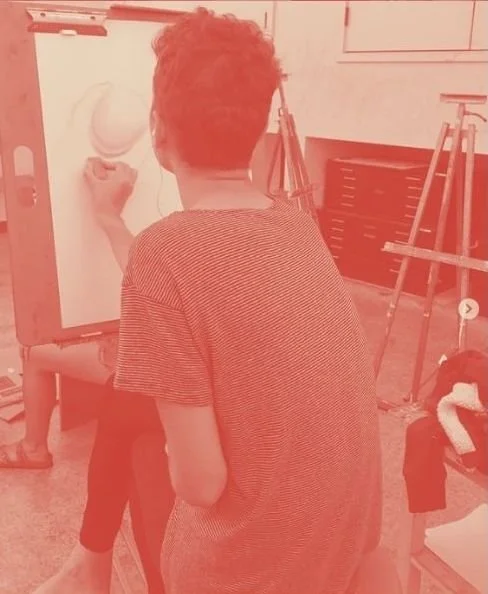Teaching

Student in Drawing Course
Courses
Casting and Mold Making / Ceramics / 2D Design / Art and Society / 3D Fabrication / Sculpture / Metal Arts / Art History / Art Appreciation / Painting / Digital Photography / 3D Design / Photography/ Drawing / Intro to Sculpture and 3D Design /
student work
A small selection is included below. A detailed student portfolio presentation is also available by request.
















teaching philosophy
I encourage a supportive-yet-rigorous classroom/ studio environment.
It is important for my students to be at ease because I want the exchange of ideas in my classroom to be free, mutual, and active; that, to me, is the essence of education.
Students should be free to express themselves artistically and feel supported to do so. I pride myself on creativity in both structuring lessons to break down barriers and devising assignments that require fresh, independent thinking.
Learning does not stop when you become a teacher. I believe in continuing to educate myself on developing artistic practices and innovative pedagogical methods. I use Sketchnotes in my Art History class. This is an innovative method of notetaking where students are asked to doodle thoughts, images, and reactions to visual lectures. Many were unsure of this process at first, but with practice, began using it fluidly. Sketchnotes are meant to help move students out of a banking model and aid in the long-term retention of information. This note style has proven to be a valuable tool. I have received several emails from former students who now use Sketchnotes for every class and some have gone on to use them in their professional lives.
I believe in actively learning from my students and using their observations to craft the flow of the class. Their experience with my assignments teaches me what works and helps me evolve as an instructor. For my 3D Design class, I meet with students during the first week and discuss what kind of sculptural methods are possible and which they are interested in trying. We talk about economic material options (as most are on a student budget) and additive vs. subtractive work. After I collect that information, I tailor my syllabus to the needs of the class. We may focus on installation, technique, or the philosophy of art if they express interest. I am always open to student feedback and make a study of their experience with the lessons. This approach helps me keep lessons fresh and effective.
To discourage whatever preconceived notions my students might bring to the studio, I try to break-down insecurities about their own abilities and ideas about the demands of the art world.
Many believe that there is a formula to produce, “good,” work. They compare themselves with professional artists and feel they cannot measure-up. I remind them that not everyone can be Augusta Savage and even she had to learn the skills associated with her craft. The students then reorient themselves through our discussion. My aim is not simply to offer an interesting “hook,” but rather to set the tone for an honest assessment of their work.
I use imagination and practical demonstration to capture my students’ interest and then guide them toward deeper insight. Art History lectures can be boring. Students have a difficult time relating to a bunch of dusty old cave paintings made thousands and thousands of years ago. I offer practical exercises that challenge the students to recreate the artwork we are studying. Hand paintings from The Cueva de las Manos in Santa Cruz, Argentina are a favorite subject. Students try different-sized straws blow paint onto their hands and make an outline on a group painting. Each person has a different outline and has chosen the color they like best. I use this lesson to show how similar they are to ancient peoples who did the same thing. The need to make one’s mark has not changed in 50,000 years.
Students in my classes learn that anyone can talk about art. There is no special or secret language meant to exclude anyone from taking part in sharing their observations.
The function of art criticism, according to a leading art theorist, E.W. Eisner, is to “…help students participate in [the] chain of looking, seeing, and experiencing, and later to transfer what they have learned to do with art to the world at large.”
During the critique-phase of a project, I use several approaches. We start out with the often-used Feldman’s model; Describe, Analyze, Interpret, Judge. Later, we move on to Barrett's Principles of Interpretation which is more abstract in its methodology. I ask for group, team and personal critiques. The class should understand that their opinions are valuable to the artist because they see things as a viewer that the artist might miss. I foster an environment where everyone feels empowered to share their observations but remain respectful of each other.
I have found that a patient teacher can help students overcome initial frustration and engage even the most complicated material in a meaningful way. All forms of diversity are welcome in my classroom and all opinions welcome. Certainly, I have days when the results are mixed, but I take those occasions as a challenge. I refuse to become complacent in my teaching. I, like my students, must always strive to improve.
